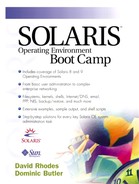Naming Systems
Each system (or network interface, to be correct) is assigned a name and, if connected to the network, an IP address. The kernel uses the address for communication but allows us to use names, as they are generally much easier to remember than batches of numbers. It also carries out any tasks that are required to map between the hostname and the IP address using something known as a “Name Service.”
Network Information Service (NIS), NIS+, Domain Name System (DNS), Lightweight Directory Access Protocol (LDAP), and “local files” are all well-known examples of naming services. We needn't be concerned with how they work or what the differences are at the moment, since we will cover this in later chapters. Suffice it to say that at present we are using “local files,” which, as the name implies, are where the host information is stored in a local file—/etc/inet/hosts (/etc/hosts is a link to /etc/inet/hosts, so use whichever you feel more familiar with). As the files are local to each machine, any changes made to one system need to be propagated onto the remaining ones.
